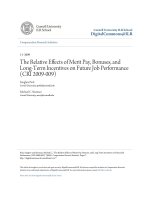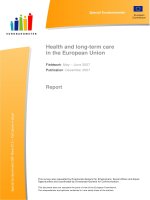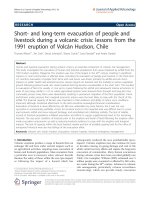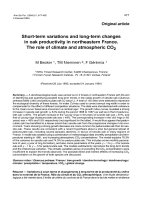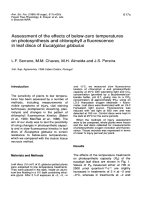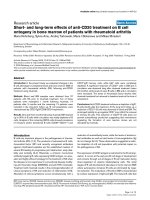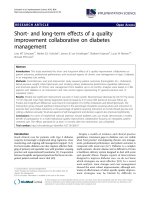The effects of antenatal corticosteroids on short and long term outcomes in small for gestational age infants
Bạn đang xem bản rút gọn của tài liệu. Xem và tải ngay bản đầy đủ của tài liệu tại đây (298.11 KB, 6 trang )
Int. J. Med. Sci. 2015, Vol. 12
Ivyspring
International Publisher
295
International Journal of Medical Sciences
Research Paper
2015; 12(4): 295-300. doi: 10.7150/ijms.11523
The Effects of Antenatal Corticosteroids on Short- and
Long-Term Outcomes in Small-for-Gestational-Age
Infants
Hiroshi Ishikawa1, Ken Miyazaki2, Tomoaki Ikeda3, Nao Murabayashi3, Kazutoshi Hayashi4, Akihiko
Kai5, Kaoru Ishikawa6, Yoshihiro Miyamoto7, Kunihiro Nishimura7, Yumi Kono8, Satoshi Kusuda9,
Masanori Fujimura10, Neonatal Research Network of Japan
1.
2.
3.
4.
5.
6.
7.
8.
9.
10.
Department of Obstetrics and Gynecology, Kanagawa Children’s Medical Center
Department of Obstetrics and Gynecology, Japanese Red Cross Nagoya Daiichi Hospital
Department of Obstetrics and Gynecology, Mie University Graduate School of Medicine
Department of Obstetrics and Gynecology, Kochi Health Sciences Center
Department of Pediatrics, Aizenbashi Hospital
Endowed Chair for Regeneration of Medicine in Kuwana District, Suzuka university of medical science
Department of Preventive Medicine and Epidemiologic Informatics, National Cerebral and Cardiovascular Center
Department of Pediatrics, Jichi Medical University
Department of Neonatology, Maternal and Perinatal Center, Tokyo Women’s Medical University
Department of Neonatology, Osaka Medical Center and Research Institute for Maternal and Child Health, Director of the Neonatal Research
Network of Japan.
Corresponding author: Hiroshi Ishikawa, M.D., Ph.D. Department of Obstetrics and Gynecology, Kanagawa Children’s Medical Center, Yokohama, Japan; Hiroshi Ishikawa 2-138-4 Mutsukawa, Minami-ku, Yokohama 232-8555, Japan. Telephone: +81 45-711-2351, Fax:
+81 45-716-5366.
© 2015 Ivyspring International Publisher. Reproduction is permitted for personal, noncommercial use, provided that the article is in whole, unmodified, and properly cited.
See for terms and conditions.
Received: 2015.01.07; Accepted: 2015.02.25; Published: 2015.03.20
Abstract
Aim: To evaluate the effect of antenatal corticosteroids (ANS) on short- and long-term outcomes
in small-for-gestational age (SGA) infants.
Methods: A retrospective database analysis was performed. A total of 1,931 single infants (birth
weight <1,500 g) born at a gestational age between 22 weeks and 33 weeks 6 days who were
determined to be SGA registered in the Neonatal Research Network Database in Japan between
2003 and 2007 were evaluated for short-term outcome and long-term outcome.
Results: ANS was administered to a total of 719 infants (37%) in the short-term outcome evaluation
group and 344 infants (36%) in the long-term outcome evaluation group. There were no significant
differences between the ANS group and the no-ANS group for primary short-term outcome
(adjusted odds ratio (OR) 0.73; 95% confidence interval (CI) 0.45-1.20; P-value 0.22) or primary
long-term outcome (adjusted OR 0.69; 95% CI 0.40-1.17; P-value 0.17).
Conclusions: Our results show that ANS does not affect short- or long-term outcome in SGA infants when the birth weight is less than 1500 g. This study strongly suggests that administration of
ANS resulted in few benefits for preterm FGR fetuses.
Key words: fetal growth restriction; glucocorticoids; infant; infant mortality; premature birth; small for gestational age
Introduction
Antenatal corticosteroid (ANS) administration in
women who are at risk for preterm labor reduces the
incidence of neonatal respiratory distress syndrome
[1], intraventricular hemorrhage (IVH), necrotizing
enterocolitis (NEC), and neonatal mortality [2]. Although administration of ANS is the most effective
intervention for risks associated with preterm birth,
the effect in some subgroups is limited. The effects of
Int. J. Med. Sci. 2015, Vol. 12
ANS in multiple pregnancies, in cases of chorioamnionitis (CAM) [3], and in cases of growth-restricted
fetuses [4] are unclear. In addition, there is considerable controversy about the effectiveness of ANS in
fetal growth restriction (FGR) [5].
The Neonatal Research Network Database is the
largest database of level III perinatal centers in Japan.
The database includes infants with birth weights at or
less than 1,500 g, herein referred to as
very-low-birth-weight (VLBW) infants, who were
treated at participating neonatal centers. Considering
the nation-wide population of VLBW infants born in
Japan during the study period, more than 50% of
VLBW infants in Japan were registered in the registry
[6]. This database contains the factors of the maternal
course (administered ANS or not), short-term outcomes, and long-term outcomes.
In this study, we conducted a retrospective
analysis of the effectiveness of ANS on the short- and
296
long-term outcomes in small-for-gestational-age
(SGA) VLBW infants, which is a very high-risk group
among preterm infants.
Materials and Methods
This was a retrospective analysis of the Neonatal
Research Network Database created with a grant from
the Ministry of Health, Labor, and Welfare of Japan in
2004. The 82 level III perinatal centers in Japan are
registered in the database (listed in the Acknowledgments). Data include infants with birth weight less
than 1,500 g. Infants who were born alive but died in
the delivery room were also included. The clinician’s
perspective on active treatment or withdrawal of care
for preterm infants born at 22 and 23 weeks of gestation depended on the clinical status of the infants.
After 23 weeks of gestation, most clinicians attempted
to save the infants. All other factors were defined as
reported previously [7].
There were 10,394 clinical cases between 2003 and 2007 (Fig. 1). Exclusion criteria were multiple pregnancies, 34 weeks of
gestation or more, uncertain gestational age,
uncertain administration of ANS, major
congenital malformation, and hospitalization following an out-of-hospital birth.
Short-term outcome evaluation was available in 5,853 cases. Of those, 3,063 cases
dropped out of the follow-up before 3 years
of age; therefore, long-term outcome was
evaluated in 2,790 cases.
These cases were classified as either
SGA or non-SGA. A birth weight below the
10th percentile for gestational age was classified as SGA. Birth weight for gestational
age was determined using the percentile
scale derived from the formula used in Japan
[Itabashi, Fujimura, Kusuda, Tamura,
Hayashi, et al. (2011) The new standard of
birth weight for gestational age. J Jpn Pediatr
Soc 114: 1271 –1293In Japanese].
ANS usage was defined as the administration of any corticosteroids to accelerate
fetal lung maturity. ANS was provided
based on the clinician's policy or perspective.
The time from ANS administration to delivery and the type of corticosteroid used were
not described in the database. It is inferred
that betamethasone was used in most of the
cases because betamethasone is the only
drug that is officially recognized in the
health insurance system of Japan for the acFigure 1. Study inclusion process for the short-term outcome evaluation group and the
celeration of fetal lung maturation.
long-term outcome evaluation group. ANS, antenatal corticosteroids; GA, gestational
age
The primary short-term outcome was
evaluated based on death occurring before
Int. J. Med. Sci. 2015, Vol. 12
discharge from a participating neonatal intensive care
unit (death in NICU). Intraventricular hemorrhage
(IVH), periventricular leukomalacia (PVL), respiratory distress syndrome (RDS), chronic lung disease of
prematurity (CLD), sepsis, late-onset adrenal insufficiency, symptomatic patent ductus arteriosus (PDA),
and necrotizing enterocolitis (NEC) were also evaluated. IVH was defined as Papile grade I or more. The
diagnosis of PVL was made based on either head ultrasound or cranial MRI scans performed at 2 weeks
of age or later. RDS was diagnosed based on the clinical and radiographic findings. CLD was defined
when an infant continued to receive supplemental
oxygen on the 28th day after birth, and 36-week CLD
was defined when an infant continued to receive
supplemental oxygen at the 36th week based on
postmenstrual age. PDA was diagnosed based on
both the echocardiographic findings and clinical evidence of a volume overload due to a left-to-right
shunt. NEC was defined according to a Bell classification [8] of stage II or greater.
For surviving VLBW infants, the follow-up protocol consisted of routine physical and neurological
evaluations and developmental assessments at 3 years
(36-42 months) of chronological age at each participating center, as reported previously [9]. The primary
long-term outcome was evaluated based on death
before 3 years of age or neurodevelopmental impairment (NDI). Infants with cerebral palsy (CP), a development quotient (DQ) < 70, and severe hearing
impairment and visual impairment were designated
as having neurodevelopmental impairment (NDI). CP
was defined as a non-progressive central nervous
system disorder characterized by abnormal muscle
tone in at least one extremity and abnormal control of
movement and posture [10]. DQ was determined using the Kyoto Scale of Psychological Development
(KSPD) test applied by psychologists at each participating center [11]; when the DQ was < 70, the infant
was judged as “delayed”. Severe hearing impairment
included the need for hearing aids. Visual impairment
was defined as unilateral or bilateral blindness diagnosed by an ophthalmologist.
The results are expressed as the mean ± SD or
median (range). Statistical analysis was performed
using the Chi2 test and t-test, as appropriate. Multivariable logistic regression analyses were performed
to assess the effect of ANS on the short- and long-term
outcomes. Odds ratios (OR) or confidence interval
(CI) were adjusted for confounding variables, and
95% confidence intervals were calculated. Multivariate logistic regression analysis was performed after
adjusting for maternal age, parity, preeclampsia, preterm rupture of membranes (PROM), non-reassuring
fetal status (NRFS), mode of delivery, gestational age
297
of delivery, birth weight, gender of the infant, and
histological CAM (≥ stage 2 according to Blanc’s classification [12]).
Statistical analyses were performed using JMP,
version 9.0.2J (SAS Institute, Cary, North Carolina,
USA). Differences were considered to be statistically
significant at P < 0.05.
All information about the infants was collected
anonymously, and the stored data were unlinked
from individual data. The protocol of this study was
approved by the central internal review board at Tokyo Women’s Medical University, where all data were
collected and stored.
Results
Short-term outcome
A total of 10,394 infants were registered in the
database between 2003 and 2007. In total, 4,541 infants
were excluded. A total of 5,853 patients were evaluated for short-term outcomes. A total of 1,929 infants
(33%) were classified as SGA, and the 3,924 remaining
infants were classified as appropriate or large for
gestational age. ANS was administered to 719 of the
SGA patients (37%).
Table 1 compares the clinical characteristics of
the ANS group and the no-ANS group in SGA infants.
The incidence of preeclampsia was low, and the incidence of PROM was high in the ANS group. The ratio
of cesarean section to vaginal birth was higher in the
ANS group. Gestational age at delivery was earlier
and birth weight was lower in the ANS group. Although RDS and CLD were more common in the ANS
group, there was no difference in the primary
short-term outcome (incidence of death before NICU
discharge) and other short-term outcome factors between the ANS group and the no-ANS group based
on univariate analysis.
To evaluate the effect of ANS on short-term
outcome in SGA infants, further analysis was performed using logistic regression analysis. Table 2
shows the odds ratios of the ANS group compared
with the no ANS group in SGA infants. Although the
incidence of PVL demonstrated a trend toward a
lower rate in the ANS group, the adjusted OR (95%
CI) was 0.73 (0.45-1.20) for the primary short-term
outcome in the ANS group compared to the no-ANS
group, significant effect of ANS was not observed in
SGA infants.
Long-term outcome
A total of 3,063 infants were excluded because of
the lack of follow-up data until 3 years of age. A total
of 2,790 patients were evaluated for long-term outcome. Of those, 949 (34%) infants were classified as
SGA. ANS was administered to 344 of the SGA infants
Int. J. Med. Sci. 2015, Vol. 12
298
(36%). The administration rate of ANS was similar to
that of the SGA infants in the short-term evaluation
group.
Table 3 shows a comparison of the clinical characteristics of the ANS group and the no-ANS group of
SGA infants. The incidence of preeclampsia was low,
and the incidence of PROM was high in the ANS
group. Gestational age at delivery was lower, and
birth weight was lower in the ANS group. Although
severe hearing impairment was uncommon in the
ANS group, there was no difference in the incidence
of death before 3 years of age and other neurodevelopment impairment factors between the ANS group
and the no-ANS group based on the univariate analysis.
To evaluate the effect of ANS on long-term outcome in SGA infants, further analysis was performed
using logistic regression analysis. Table 4 shows the
odds ratios of the ANS group compared to the
no-ANS group of SGA infants. The adjusted OR (95%
CI) was 0.69 (0.40-1.17) for the primary long-term
outcomes in the ANS group compared to the no-ANS
group; a significant long-term effect of ANS was not
found in SGA infants.
Table 1. Comparison of the clinical characteristics and the results
of the univariate analysis of the ANS group and the no-ANS group
in the short-term outcome evaluation group of SGA infants
(n=1929)
Maternal age
Nulliparous
Preeclampsia
Diabetes
PROM
NRFS
Cesarean section
GA at delivery
Birth weight
Male gender
Histological CAM (≥stage 2)
Clinical CAM
Death during NICU hospitalization
IVH
PVL
RDS
CLD
Sepsis
Late-onset adrenal insufficiency
PDA
NEC
ANS (n=719)
32.0 ± 4.9
437/719 (61%)
318/719 (44%)
8/719 (1%)
124/719 (17%)
309/719 (43%)
661/719 (92%)
29.1 ± 2.6
886±298
386/717 (54%)
46/507 (9%)
43/717 (6%)
56/719 (8%)
no ANS (n=1210)
32.1 ± 5.0
746/1210(62%)
605/1209 (50%)
25/1210 (2%)
118/1210 (10%)
530/1209 (44%)
1058/1210 (87%)
29.7 ± 2.7
959±313
615/1209 (51%)
46/838 (5%)
75/1199 (6%)
92/1210 (8%)
P value
.50
.70
.0134*
.11
< .0001*
.71
.0018*
< .0001*
< .0001*
.21
.0129*
.82
.88
54/719 (8%)
11/719 (2%)
341/719 (47%)
194/719 (27%)
51/719 (7%)
53/719 (7%)
175/719 (24%)
13/719 (2%)
99/1210 (8%)
28/1210 (2%)
510/1210 (42%)
250/1210 (21%)
75/1210 (6%)
67/1210 (5%)
268/1210 (22%)
15/1210 (1%)
.60
.23
.0241*
.0015*
.44
.11
.27
.31
ANS, antenatal corticosteroids; PROM, preterm rupture of membranes; NRFS,
non-reassuring fetal status; GA, gestational age; CAM; chorioamnionitis; NICU,
neonatal intensive care unit; IVH, intraventricular hemorrhage; PVL, periventricular leukomalacia; RDS, respiratory distress syndrome; CLD, chronic lung disease of
prematurity; PDA, symptomatic patent ductus arteriosus; NEC, necrotizing enterocolitis.
Table 2. The results of multiple logistic analysis of the short-term
outcome showing the adjusted odds ratio of the ANS group
compared to the no-ANS group
Death during NICU hospitalization
IVH
PVL
RDS
CLD
Sepsis
Late-onset adrenal insufficiency
PDA
NEC
Adjusted OR†
0.73
0.79
0.44
1.10
1.18
0.95
0.94
1.01
1.04
95% CI
0.45-1.20
0.51-1.21
0.17-1.03
0.84-1.44
0.87-1.62
0.59-1.53
0.59-1.50
0.76-1.34
0.43-2.48
P value
.22
.28
.06
.48
.29
.84
.80
.96
.92
ANS, antenatal corticosteroids; NICU, neonatal intensive care unit; IVH, intraventricular hemorrhage; PVL, periventricular leukomalacia; RDS, respiratory
distress syndrome; CLD, chronic lung disease of prematurity; PDA, symptomatic
patent ductus arteriosus; NEC, necrotizing enterocolitis.
†Adjusted for maternal age, parity, preeclampsia, PROM, NRFS, mode of delivery,
gestational age at delivery, birth weight, gender of the infant, and histological CAM
(≥ stage 2).
Table 3. Comparison of the clinical characteristics and the results
of the univariate analysis of the ANS group and the no-ANS group
in the long-term outcome evaluation group of SGA infants (n=949)
Maternal age
Nulliparous
Preeclampsia
Diabetes
PROM
NRFS
Cesarean section
GA at delivery
Birth weight
Male gender
Histological CAM (>stage 2)
Clinical CAM
Death before 3 years of age
Neurodevelopment impairment
Cerebral palsy
DQ<70
Severe hearing impairment
Visual impairment
Death before 3 years of age or
NDI
ANS (n=344)
32.2 ± 4.9
215/344 (63%)
135/344 (39%)
5/344 (1%)
67/344 (19%)
148/344 (43%)
314/344 (91%)
28.7 ± 2.7
829 ± 294
190/342 (56%)
28/234 (12%)
24/344 (7%)
59/344 (17%)
66/285 (23%)
no ANS (n=605)
32.1 ± 5.0
391/605 (65%)
307/605 (51%)
15/605 (2%)
55/605 (9%)
277/605 (46%)
534/605 (88%)
29.2 ± 2.8
900 ± 320
316/604 (52%)
23/436 (5%)
43/598 (7%)
100/605 (16%)
93/505 (18%)
P value
.68
.51
.0006*
.27
< .0001*
.41
.14
.0025*
.0005*
.33
.0024*
.90
.81
.11
19/278 (7%)
51/271 (19%)
0/277 (0%)
1/275 (0%)
125/344 (36%)
25/498 (5%)
70/486 (14%)
5/502 (1%)
3/490 (1%)
193/605 (31%)
.30
.12
.0357*
.64
.16
ANS, antenatal corticosteroids; PROM, preterm rupture of membranes; NRFS,
non-reassuring fetal status; GA, gestational age; CAM; chorioamnionitis; DQ,
development quotient; NDI, neurodevelopmental impairment.
Table 4. The results of multiple logistic analysis of the long-term
outcome showing the adjusted odds ratio of the ANS group
compared with the no ANS group
Death before 3 years of age
Neurodevelopment impairment
Cerebral palsy
DQ<70
Severe hearing impairment
Visual impairment
Death before 3 years of age or NDI
Adjusted OR†
0.69
1.03
1.12
1.08
1.03
0.83
95%CI
0.40-1.17
0.62-1.70
0.41-2.96
0.63-1.85
0.00-1.42
0.02-36.15
0.54-1.27
P value
.17
.90
.82
.78
.08
.99
.39
ANS, antenatal corticosteroids; DQ, development quotient; NDI, neurodevelopmental impairment.
†Adjusted for maternal age, parity, preeclampsia, PROM, NRFS, mode of delivery,
gestational age at delivery, birth weight, gender of the infant, and histological CAM
(≥stage 2).
Int. J. Med. Sci. 2015, Vol. 12
Discussion
Despite the established benefits of antenatal
glucocorticoids for neonatal lung function and viability in normal-size premature infants, there is considerable controversy concerning the effectiveness of
ANS in growth-restricted premature infants.
A large retrospective study found that the ANS
affects fetal outcome even in cases of SGA. According
to “The Vermont Oxford Network”, ANS lowered the
incidence of RDS, IVH, and perinatal death in both
normal and growth-restricted newborns from 25 to 30
weeks gestation. The authors concluded that the benefits of ANS are not dependent on fetal growth [13].
In contrast, another study showed that ANS resulted in few benefits in cases of FGR. Elimian et al.
found that there was no difference due to ANS in the
incidence of RDS, IVH, PVL, NEC, and neonatal
mortality in a retrospective study [4]. The case-control
study of 62 pairs with growth-restriction due to placental insufficiency indicated that the survival rate
without disability or handicap at 2 years corrected age
was higher in the ANS group, but there was a statistically significant negative effect on physical growth
in the long-term follow-up at school age. Schaap et al.
concluded that the benefits from ANS for
growth-restricted infants outweigh the possible adverse effects [14].
Several mechanisms of the ANS effect on FGR
have been proposed. Early studies showed that that
plasma cortisol levels in SGA fetuses were higher than
in appropriate-for-gestational-age infants, suggesting
that the ANS effect was attenuated [15]. Accordingly,
the risk of RDS in FGR fetuses without ANS should
decrease, but in fact, it increases [16]. A recent study
of sheep fetuses with uterine artery ligation (an induced FGR model) showed no changes in surfactant
protein gene expression when plasma cortisol concentrations were increased [17]. These studies suggest
reactivity to corticosteroid concerning the pulmonary
maturity deficits in FGR.
Administration of ANS for FGR might compromise cardiovascular function. A sheep study demonstrated that carotid blood flow decreased after the
administration of betamethasone in an induced FGR
model [18]. In contrast, human growth-restricted fetuses showed absent or reversed end-diastolic umbilical artery flow. Blood flow in umbilical arteries and
veins increased after intramuscular injections of betamethasone in some cases [19]. Thus, the effects of
ANS on the cardiovascular system and on prognosis
warrant further investigation.
Our study demonstrated that ANS has no effect
on the short- and long-term outcome in SGA infants.
Mori et al. demonstrated that ANS improved
short-term outcome using the same database [20], but
299
their study did not delineate between SGA infants
and non-SGA infants. This is the first large sample
size retrospective study examining the effect of ANS
on long-term outcomes in SGA infants.
The strength of this study is its large sample size.
In addition, little distortion of the results due to inconsistent neonatal medical care is expected because
the same health insurance system of Japan is provided
to most inhabitants.
The limitations of our study are that it is a retrospective and multicenter study. The type of ANS
and the days from ANS to delivery are not described
in this database and are expected to vary. Although
we excluded major malformation, the causes of SGA
vary and are not described in the database, and it is
expected that the response to ANS varies according to
the cause of SGA. Another limitation is that the ANS
administration rate was low. We suppose the reason
for this was that ANS was not authorized in the public
insurance institution of Japan until 2009; our study
subjects were born between 2003 and 2007.
In summary, ANS is not effective to improve the
short- or long-term outcome of SGA infants when the
birth weight is less than 1500 g. This study strongly
suggests that the administration of ANS resulted in
few benefits for preterm FGR fetuses. For randomization to be ethically justified, further study is needed to
clarify ANS activity for FGR fetuses.
Abbreviations
ANS:
antenatal
corticosteroids;
SGA:
small-for-gestational age; IVH: intraventricular hemorrhage; NEC: necrotizing enterocolitis; CAM: chorioamnionitis; FGR: fetal growth restriction; VLBW:
SGA:
very-low-birth-weight;
small-for-gestational-age; NDI: neurodevelopmental
impairment; CP: cerebral palsy; DQ: development
quotient
Acknowledgements
We wish to thank the institutions and representative physicians enrolled in the Neonatal Research Network Database in Japan, which include the
following: Sapporo City General Hospital: S. Hattori;
Kushiro Red Cross Hospital: A. Noro; Aomori Prefectural Central Hospital: T. Amizuka; Iwate Medical
University: S. Chida; Sendai Red Cross Hospital: R.
Takahashi; Akita Red Cross Hospital: H.Arai; Fukushima Medical University: T. Imamura; National Fukushima Hospital: N. Ujiie; University of Tsukuba: Y.
Miyazono; Tsuchiura Kyodo General Hospital: J.
Shimizu; Dokkyo Medical University: H. Suzumura;
Jichi Medical University: Y. Kono; Saitama Children’s
Medical Center: M. Shimizu; Saitama Medical University Saitama Medical Center: T. Kunikata; Gunma
Int. J. Med. Sci. 2015, Vol. 12
Children’s Medical Center: T. Fujiu; Kameda Medical
Center: H. Sato; Tokyo Women’s Medical University
Yachiyo Medical Center: T. Kondo; Tokyo Metropolitan Bokuto Hospital: T. Watanabe; Showa University:
M. Aizawa; Tokyo Women’s Medical University: A.
Uchiyama; Nihon University Itabashi Hospital: M.
Makimoto; Teikyo University: J. Hoshi; Toho University: H. Yoda; Japan Red Cross Medical Center: Y.
Kawakami; Aiiku Hospital: N. Ishii; National Center
for Child Health and Development: Y. Ito; Kanagawa
Children’s Medical Center: H. Itani; Yokohama City
University Medical Center: K. Seki; Tokai University:
M. Nomura; Kitazato University: M. Nowatari; Yamanashi Prefectural Central Hospital: A. Nemoto;
Nagaoka Red Cross Hospital: O. Nagata; Niigata City
Hospital: Y. Nagayama; Nagano Children’s Hospital:
T. Nakamura; Shinshu University: M. Okada; Iida
City Hospital: S. Nakata; National Nagano Hospital:
E. Shimazaki; Saku General Hospital: T. Yoda; Toyama Prefectural Central Hospital: T. Hutatani; Ishikawa Prefectural Central Hospital: Y. Ueno; Fukui Prefectural Hospital: K. Iwai; Shizuoka Children’s Hospital: Y. Nakazawa; Seirei Hamamatsu General Hospital: S. Oki; Nagoya Red Cross First Hospital: C.
Suzuki; National Mie Hospital: M. Bonno; Gifu Prefectural Central Hospital: Y. Kawano; Otsu Red Cross
Hospital: K. Nakamura; Kyoto Red Cross First Hospital: N. Mitsufuji; Osaka Medical Center and Research Institute for Maternal and Child Health: J.
Shiraishi; Osaka City General Hospital: H. Ichiba;
Takatsuki Hospital: H. Minami; Yodogawa Christian
Hospital: H. Wada; Kansai Medical University: A.
Ohashi; Aizenbashi Hospital: K. Sumi; Nara Medical
University: Y. Takahashi; Wakayama Prefectural
Medical University: T. Okutani; Hyogo Prefectural
Kobe Children’s Hospital: S. Yoshimoto; Tottori University: I. Nagata; Shimane Prefectural Central Hospital: E. Kato; Kurashiki Central Hospital: S. Watabe S;
National Okayama Hospital: M. Kageyama; Hiroshima Prefectural Hospital: R. Fukuhara; Hiroshima
City Hospital: M. Hayashitani; Yamaguchi Prefectural
Medical Center: K. Hasegawa; National Kagawa
Children’s Hospital: A. Ohta; Kagawa University: T.
Kuboi; Ehime Prefectural Central Hospital: S. Akiyoshi; Kochi Health Sciences Center: K. Kikkawa; Tokushima University: T. Saijo; St. Mary’s Hospital: S.
Shimokawa; Kitakyushu City Municipal Medical
Center: N. Matsumoto; Kurume University: H. Kanda;
Fukuoka University: E. Oota; National Kyushu Medical Center: G. Kanda; Kyushu University: M. Ochiai;
National Nagasaki Medical Center: M. Aoki; Kumamoto City Hospital: Y. Kondo; Kumamoto University:
M. Iwai; Oita Prefectural Hospital: K. Iida; Miyazaki
University: T. Ikenoue; Kagoshima City Hospital: S.
Ibara; Okinawa Chubu Hospital: M. Kohama.
300
Competing Interests
This study was partly supported by a grant from
the Ministry of Health, Labor and Welfare, Japan.
References
1.
2.
3.
4.
5.
6.
7.
8.
9.
10.
11.
12.
13.
14.
15.
16.
17.
18.
19.
20.
Liggins GC, Howie RN. A controlled trial of antepartum glucocorticoid
treatment for prevention of the respiratory distress syndrome in premature
infants. Pediatr. 1972; 50: 515-525.
Crowley PA. Antenatal corticosteroid therapy: a meta-analysis of the randomized trials, 1972 to 1994. Am J Obstet Gynecol. 1995; 173: 322-335
[DOI:10.1016/0002-9378(95)90222-8].
Roberts D, Dalziel S. Antenatal corticosteroids for accelerating fetal lung
maturation for women at risk of preterm birth. Cochrane Database Syst Rev.
2006; 19: CD004454; CD004454 [DOI:10.1002/14651858.CD004454.pub2].
Elimian A, Verma U, Canterino J, et al. Effectiveness of antenatal steroids in
obstetric
subgroups.
Obstet
Gynecol.
1999;
93:
174-179
[DOI:10.1016/S0029-7844(98)00400-1].
Morrison JL, Orgeig S. Antenatal glucocorticoid treatment of the
growth-restricted fetus: benefit or cost? Reprod Sci. 2009; 16: 527-538
[DOI:10.1177/1933719109332821].
Kusuda S, Fujimura M, Uchiyama A, et al. Neonatal Research Network. Japan.
trends in morbidity and mortality among very-low-birth-weight infants from
2003 to 2008 in Japan. Pediatr Res. 2012; 72: 531-538. [DOI:
10.1038/pr.2012.114.]
Kusuda S, Fujimura M, Sakuma I, et al.. Neonatal Research Network. Morbidity and mortality of infants with very low birth weight in Japan: center variation. Pediatr. 2006; 118: e1130-8 [DOI:10.1542/peds.2005-2724].
Bell MJ, Ternberg JL, Feigin RD, et al. Neonatal necrotizing enterocolitis.
Therapeutic decisions based upon clinical staging. Ann Surg. 1978; 187: 1-7
[DOI:10.1097/00000658-197801000-00001].
Kono Y, Mishina J, Yonemoto N, et al. Outcomes of very-low-birthweight
infants at 3 years of age born in 2003-2004 in Japan. Pediatr Int. 2011; 53:
1051-1058 [DOI:10.1111/j.1442-200X.2011.03480.x].
Bax MC. Terminology and classification of cerebral palsy. Dev Med Child
Neurol. 1964; 6: 295-297 [DOI:10.1111/j.1469-8749.1964.tb10791.x].
Koyama T, Osada H, Tsujii H, et al. Utility of the Kyoto scale of psychological
development in cognitive assessment of children with pervasive developmental disorders. Psychiatry Clin Neurosci. 2009; 63: 241-243
[DOI:10.1111/j.1440-1819.2009.01931.x].
Blanc WA. Pathology of the placenta, membranes, and umbilical cord in
bacterial, fungal, and viral infections in man. Monogr Pathol. 1981; 22: 67-132.
Bernstein IM, Horbar JD, Badger GJ, et al. Morbidity and mortality among
very-low-birth-weight neonates with intrauterine growth restriction. The
Vermont Oxford Network. Am J Obstet Gynecol. 2000; 182: 198-206
[DOI:10.1016/S0002-9378(00)70513-8].
Schaap AH, Wolf H, Bruinse HW, et al. Effects of antenatal corticosteroid
administration on mortality and long-term morbidity in early preterm,
growth-restricted
infants.
Obstet
Gynecol.
2001;
97:
954-960
[DOI:10.1016/S0029-7844(01)01343-6].
Economides DL, Nicolaides KH, Linton EA, et al. Plasma cortisol and adrenocorticotropin in appropriate and small for gestational age fetuses. Fetal
Ther. 1988; 3: 158-164 [DOI:10.1159/000263348].
McIntire DD, Bloom SL, Casey BM, et al. Birth weight in relation to morbidity
and mortality among newborn infants. N Engl J Med. 1999; 340: 1234-1238
[DOI:10.1056/NEJM199904223401603].
Sutherland AE, Crossley KJ, Allison BJ, et al. The effects of intrauterine growth
restriction and antenatal glucocorticoids on ovine fetal lung development.
Pediatr Res. 2012; 71: 689-696 [DOI:10.1038/pr.2012.19].
Miller SL, Chai M, Loose J, et al. The effects of maternal betamethasone administration on the intrauterine growth-restricted fetus. Endocrinology. 2007;
148: 1288-1295 [DOI:10.1210/en.2006-1058].
Simchen MJ, Alkazaleh F, Adamson SL, et al. The fetal cardiovascular response to antenatal steroids in severe early-onset intrauterine growth restriction.
Am
J
Obstet
Gynecol.
2004;
190:
296-304
[DOI:10.1016/j.ajog.2003.08.011].
Mori R, Kusuda S, Fujimura M, et al. Antenatal corticosteroids promote
survival of extremely preterm infants born at 22 to 23 weeks of gestation. J
Pediatr. 2011; 159: 110-114 [DOI:10.1016/j.jpeds.2010.12.039].
